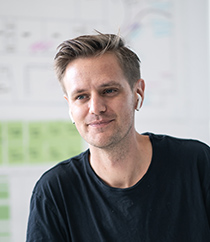
Article
Why Excellent Product Design Might Mean Letting Go of the Concept You Love
Even after hiring designers, clients often remain precious about initial concepts. Learn why the right firm is willing to tell you if your baby is ugly.
No one wants to hear their baby is ugly. And in the world of product design, no one wants to hear their design is bad. But sometimes clients come to us as proud as a brand-new parent. They show us their napkin sketch like a mom wielding a photo album. “Look, isn’t it great? Perfect, right?”
Sometimes that napkin sketch really is as amazing as the would-be designer thinks it is. But more often than not, we look at it with the objectivity its enthusiastic creator can’t seem to muster. And what we see is a whole lot of potential — potential that needs to be molded into something entirely different in order to help the client best meet their business goals.
If you want unfettered admiration for your design concepts, M3 Design is not the firm for you. We simply aren’t interested in wasting your time and money to develop a bad design.
But if you’re up for some healthy debate and open to exploring how to turn your idea into the best, most innovative solution possible, we’ll work tirelessly to deliver the end result your product idea deserves. Here’s how.
Product Design Demands a Relentless Commitment to Excellence
Product design can’t be about your ego. It’s about excellence. That’s why we drop our egos at the door and ask clients to do the same. To arrive at the best end result, it’s essential to embrace the tension and competitive collaboration that comes with exploring different options. There’s no direct route to your product design destination. Rather, the process is often like a twisty, bumpy road that involves countless detours and frequent stops and starts.
Along the way, we fiercely push each other to be more innovative and find better solutions to your complex problems. No wayward designer hijinks allowed. Through spirited back and forth, we eventually wrestle your initial design idea into a variety of workable concepts.
Although we would never present concepts to you that we don’t fully believe in, there are times when we feel strongly about one design over another. That’s not just because we like it best — it’s because we believe in its potential to better meet your objectives and deliver the ROI you need. When this is the case, we’re willing to fight to give that concept the best possible chance of seeing the light of day.
When A “Good Enough” Design Isn’t Good Enough
We recently presented one of our clients with an array of concept options. All were workable and met the basic product requirements. But one was truly innovative and exciting. It was different from anything else on the market and had the potential to set our client apart from competitors in new ways. This client tends toward risk aversion, though, so they naturally selected the safest bet out of the options presented.
In this case, we felt strongly that the more ambitious concept was the best possible solution for the client — they just couldn’t see it yet. Therefore, we decided to develop a prototype of the concept they chose and of the one we thought was superior. We worked on the rejected concept on our own time, putting in additional hours over several late nights and weekends to pull it off.
When it was time to present a working prototype to the client and their key stakeholders, we pitched their chosen concept along with the one they’d previously shot down. After seeing our preferred option in action and observing how it answered the problem better than the other concept, they were blown away. Ultimately, they selected the better concept for development.
We don’t always create alternatives to our clients’ preferences, but in this case, we felt strongly that a bigger risk needed to be taken. We were prepared to move on if the client had chosen the safer option, but we wanted to give the more exciting design one last shot. Although we can accept it when the answer is no, we’ll always advocate for what we feel is the best option until the client makes their final decision. Every single time.
A Good Design Firm Doesn’t Blindly Take Orders
The above scenario could have ended differently. The client could have stuck with their original decision and rolled their eyes at our zeal. That would have been ok. We’ve built enough rapport with this client that they understand the methods behind our madness. They know we have their best interests at heart. And as we said, both product options were good.
But a design firm worth its price tag is not a mere order taker. So when you engage one, you should resist the urge to tell them exactly how to proceed. You hired a team of experts for a reason. Explain the market opportunity. Thoroughly explore user needs. Participate fully in the process. Offer helpful feedback. But at the end of the day, let the designers do what they do best and bring the full suite of their expertise to the problem you’re trying to solve.
Your Product Design Must be Tested and Validated if You Want ROI
When clients identify a hole in their market, we love to help them fill that gap with a right-fit product. But sometimes clients come to us with a design idea they’re really invested in and want us to make that concept work, no questions asked.
Here’s the deal. You may have the best product idea in the world and might have even brainstormed a great solution. But if you don’t know how to get the product to market, don’t understand what it takes to manufacture a product in large volumes, or haven’t taken time to understand who your user personas are and what they need, you won’t reach the goals you’re trying to reach with your product. It’s that simple.
That’s why we filter every concept through five areas — production volume, manufacturability, marketability, usability, and go-to-market strategy. Applying these factors serves to objectively demonstrate the ways the product design needs to be adjusted in order to achieve the successful outcome you’re expecting.
Another way to make sure a product design will pass muster is to put it through external validation. Focus groups and online consumer surveys are quick and helpful ways to validate the product with end-users. Taking a prototype to the environment where it will be used and asking for unbiased feedback from stakeholders is another effective method to test the product.
If the design concept doesn’t stand up to validation, you won’t achieve the results you want. If you can’t achieve results, it’s time to let go of that concept and collaborate with us to create a better one. After all, if you don’t get the ROI you’re after, what’s the point?
Ready to Engage a Passionate, Results-Oriented Design Firm?
Maybe you’re holding a napkin sketch of your design idea right now. Maybe you’ve even gone to the expense of independently developing a full-blown prototype. And now, you’re looking for the perfect firm to make your concept a reality.
Take a deep breath. Look at your design. Are you ready to invite a partner in to help you bring your concept to life? Even if they say what you’re holding in your hand isn’t good enough? Even if they call your baby ugly?
If you want the ROI your product deserves, you’ll answer those questions by giving us a call.





